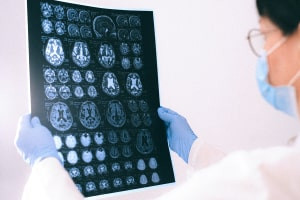This course maps this connection and teaches you the components and functions of the human central nervous system. We explain the technical science behind electroencephalograms (EEGs), electrical brain stimulation, event-related potentials and the manufacturing of electrodes and circuits used in neuroscience instruments. We begin by investigating the human central nervous system’s architecture, starting with the neuron. This means examining the neuron’s components, including axons and dendrites, and seeing how they extend to form neuronal circuits. We offer an intriguing close look at the neuron’s cell membrane and its ionic channels’ electric-chemical properties. Understanding the neuron’s cell membrane function is crucial in understanding how these nerve cells exchange information with each other via neuronal synapses and action potentials.
We continue our study of the central nervous system with attention to the cerebrum’s anatomical structure, the cerebellum and the spinal cord. We examine the functions of the cerebrum’s four lobes and the purpose of sulci (grooves) and gyri (folds) on the surface of the cerebrum. We go through the use of nanotechnology in manufacturing the primary tools used for EEG recordings, including voltage and patch clamps. We demonstrate how to place electrodes on the scalp to perform an EEG and break down the intricacies of resting membrane potential and the mechanics of action potentials. The course compares intracellular and extracellular recordings in measuring membrane potentials before moving on to neurobiology and axonology. These exciting fields show how neurons are both chemically and electrically stimulated and we demonstrate how to mathematically model synaptic potentials and action potentials so that they can provide a theoretical description of neuronal activity.
The course then moves on to brain stimulation techniques that can treat depression and chronic pain: transcranial direct current stimulation, transcranial magnetic stimulation and electro-convulsive therapy. Next, we show you how to record event-related potentials or the brain’s voltage changes preceding specific visual, auditory or sensory stimuli to evaluate mental function. You will learn what different event-related potentials reveal about a patient's health and the equipment needed to record them. We conclude by studying the manufacture of chips, sensors and other electrical components used in electrophysiological recordings. Imagine those suffering from Alzeheimer’s or Parkinson’s regaining their faculties and physical capabilities or enhancing mental performance to increase an individual’s intelligence. That is the potential future of neuroscience. This course is complex, challenging and rewarding for anyone studying neuroscience or medical professionals interested in understanding neurophysiology and the instruments used to monitor, study and evaluate the human central nervous system. This course also suits anyone with a curious mind who wants to know how it got that way.
What You Will Learn In This Free Course
View All Learning Outcomes View Less All Alison courses are free to enrol, study, and complete. To successfully complete this Diploma course and become an Alison Graduate, you need to achieve 80% or higher in each course assessment.
Once you have completed this Diploma course, you have the option to acquire an official Diploma, which is a great way to share your achievement with the world.
Your Alison certificate is:
- Ideal for sharing with potential employers.
- Great for your CV, professional social media profiles, and job applications.
- An indication of your commitment to continuously learn, upskill, and achieve high results.
- An incentive for you to continue empowering yourself through lifelong learning.
Alison offers 2 types of Diploma for completed Diploma courses:
- Digital Diploma: a downloadable Diploma in PDF format immediately available to you when you complete your purchase.
- Physical Diploma: a physical version of your officially branded and security-marked Diploma
All Diplomas are available to purchase through the Alison Shop. For more information on purchasing Alison Diploma, please visit our FAQs. If you decide not to purchase your Alison Diploma, you can still demonstrate your achievement by sharing your Learner Record or Learner Achievement Verification, both of which are accessible from your Account Settings.











 Avg. Hours
Avg. Hours  Contains Video
Contains Video  CPD Accredited
CPD Accredited 
 Total XP:
Total XP: 
 Knowledge & Skills You Will Learn
Knowledge & Skills You Will Learn 






